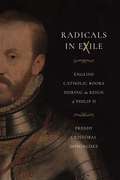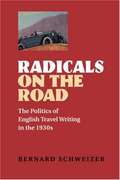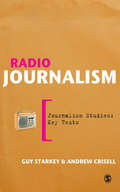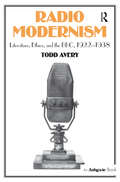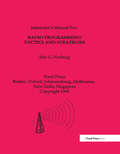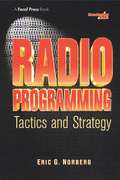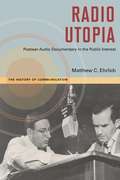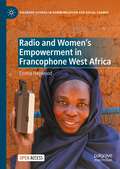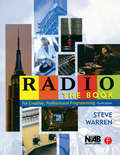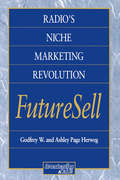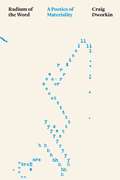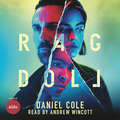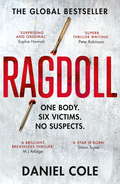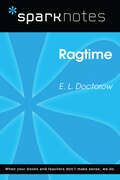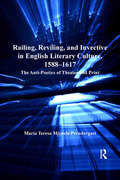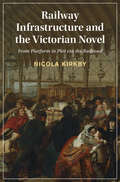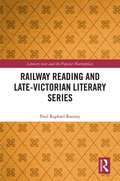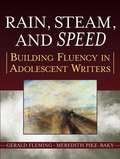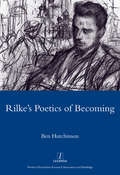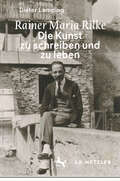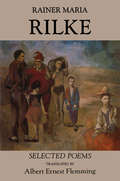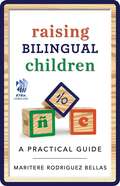- Table View
- List View
Radicals in Exile: English Catholic Books During the Reign of Philip II (Iberian Encounter and Exchange, 475–1755)
by Freddy Cristóbal DomínguezFacing persecution in early modern England, some Catholics chose exile over conformity. Some even cast their lot with foreign monarchs rather than wait for their own rulers to have a change of heart. This book studies the relationship forged by English exiles and Philip II of Spain. It shows how these expatriates, known as the “Spanish Elizabethans,” used the most powerful tools at their disposal—paper, pens, and presses—to incite war against England during the “messianic” phase of Philip’s reign, from the years leading up to the Grand Armada until the king’s death in 1598.Freddy Cristóbal Domínguez looks at English Catholic propaganda within its international and transnational contexts. He examines a range of long-neglected polemical texts, demonstrating their prominence during an important moment of early modern politico-religious strife and exploring the transnational dynamic of early modern polemics and the flexible rhetorical approaches required by exile. He concludes that while these exiles may have lived on the margins, their books were central to early modern Spanish politics and are key to understanding the broader narrative of the Counter-Reformation.Deeply researched and highly original, Radicals in Exile makes an important contribution to the study of religious exile in early modern Europe. It will be welcomed by historians of early modern Iberian and English politics and religion as well as scholars of book history.
Radicals on the Road: The Politics of English Travel Writing in the 1930s
by Bernard SchweizerIn the 1930s, the discourse of travel furthered widely divergent and conflicting ideologies--socialist, conservative, male chauvinist, and feminist--and the major travel writers of the time revealed as much in their texts. Evelyn Waugh was a declared conservative and fascist sympathizer; George Orwell was a dedicated socialist; Graham Greene wavered between his bourgeois instincts and his liberal left-wing sympathies; and Rebecca West maintained strong feminist and liberationist convictions. Bernard Schweizer explores both the intentional political rhetoric and the more oblique, almost unconscious subtexts of Waugh, Orwell, Greene, and West in his groundbreaking study of travel writing's political dimension. Radicals on the Road demonstrates how historically and culturally conditioned forms of anxiety were compounded by the psychological dynamics of the uncanny, and how, in order to dispel such anxieties and to demarcate their ideological terrains, 1930s travelers resorted to dualistic discourses.Yet any seemingly fixed dualism, particularly the opposition between the political left and the right, the dichotomy between home and abroad, or the rift between utopia and dystopia, was undermined by the rise of totalitarianism and by an increasing sense of global crisis--which was soon followed by political disillusionment. Therefore, argues Schweizer, traveling during the 1930s was more than just a means to engage the burning political questions of the day: traveling, and in turn travel writing, also registered the travelers' growing sense of futility and powerlessness in an especially turbulent world.
Radio Empire: The BBC’s Eastern Service and the Emergence of the Global Anglophone Novel (Modernist Latitudes)
by Daniel Ryan MorseInitially created to counteract broadcasts from Nazi Germany, the BBC’s Eastern Service became a cauldron of global modernism and an unlikely nexus of artistic exchange. Directed at an educated Indian audience, its programming provided remarkable moments: Listeners in India heard James Joyce reading from Finnegans Wake on the eve of independence, as well as the literary criticism of E. M. Forster and the works of Indian writers living in London.In Radio Empire, Daniel Ryan Morse demonstrates the significance of the Eastern Service for global Anglophone literature and literary broadcasting. He traces how modernist writers used radio to experiment with form and introduce postcolonial literature to global audiences. While innovative authors consciously sought to incorporate radio’s formal features into the novel, literature also exerted a reciprocal and profound influence on twentieth-century broadcasting. Reading Joyce and Forster alongside Attia Hosain, Mulk Raj Anand, and Venu Chitale, Morse demonstrates how the need to appeal to listeners at the edges of the empire pushed the boundaries of literary work in London, inspired high-cultural broadcasting in England, and formed an invisible but influential global network.Adding a transnational perspective to scholarship on radio modernism, Radio Empire demonstrates how the history of broadcasting outside of Western Europe offers a new understanding of the relationship between colonial center and periphery.
Radio Journalism (Journalism Studies: Key Texts)
by Andrew Crisell Guy Starkey"This is not another turgid guide to digital editing, writing for radio and the structure of a newsroom team. It is an ambitious and accessible study that combines a succinct narrative history of radio journalism with an analysis of its power in the public sphere. It describes the development of British audio broadcasting before locating it in an international context and contemplating the contours of the convergent future. Such ambition is often the prelude to failure. Instead, Starkey and Crisell have written a precious introduction to the theory, practice and purposes of radio journalism that will be very useful to serious students of the subject... This is a very good book." - THE (Times Higher Education) Radio Journalism introduduces key themes in journalism studies to explore what makes radio reporting distinctive and lay out the claims for radio's critical importance in the news landscape. With their extensive experience in radio production and academica, authors Guy Starkey and Andrew Crisell take readers on a tour through the past, present and future of radio broadcasting, from the infancy of the BBC in the 1920s up to the prospect of rolling news delivered to mobile telephones. Grounding each chapter in a survey of scholarly writing on the radio, they explore the connections between politics, policy and practice, inviting critical reflection on who radio professionals are, what they do and why. Putting theory and practice into dialogue, this book is the perfect bridge between unreflective production manuals and generalised media theory texts. Witty and engaging, Radio Journalism provides an essential framework for understanding the continuing relevance of radio journalism as a profession, set of practices and arena for critical debate. ks within particular types of journalism; a review of contemporary practices; social demographics; a comparative analysis of practices around the world; a summary of main conceptual approaches; an indication of future directions; recommendations for further reading. This strong organization resembles a template for a course outline. This is intentional because the series is aimed both at students and their practice-based lecturers, who often come straight from industry and need time to adjust to the academic environment... [The series] achieves its aim to bridge the sometimes too evident dissonance between journalism theory and practice... They successfully situate discussions about journalism in social and historical contexts. We see the faces of individual journalists, the circumstances of news production, the relationship with owners, the battle between the public service and the profit nature of news, the relevance of journalism work. The detailed account of the conditions under which newspaper, radio and alternative journalism is produced and performed make the Journalism Studies: Key Texts series mandatory reading for both journalism students and their lecturers' - Verica Rupar, Journalism Studies
Radio Modernism: Literature, Ethics, and the BBC, 1922–1938
by Todd AveryRadio Modernism marries the fields of radio studies and modernist cultural historiography to the recent 'ethical turn' in literary and cultural studies to examine how representative British writers negotiated the moral imperative for public service broadcasting that was crafted, embraced, and implemented by the BBC's founders and early administrators. Weaving together the institutional history of the BBC and developments in ethical philosophy as mediated and forged by writers such as T. S. Eliot, H. G. Wells, E. M. Forster, and Virginia Woolf, Todd Avery shows how these and other prominent authors' involvement with radio helped to shape the ethical contours of literary modernism. In so doing, Avery demonstrates the central role radio played in the early dissemination of modernist art and literature, and also challenges the conventional assertion that modernists were generally elitist and anti-democratic. Intended for readers interested in the fields of media and cultural studies and modernist historiography, this book is remarkable in recapturing for a twenty-first-century audience the interest, fascination, excitement, and often consternation that British radio induced in its literary listeners following its inception in 1922.
Radio Programming Tactics and Strategies
by NorbertFirst published in 2002. Routledge is an imprint of Taylor & Francis, an informa company.
Radio Programming: Tactics And Strategy (Broadcasting And Cable Ser.)
by Eric NorbergA practical handbook for programming directors, this guide focuses on achieving specific objectives in today's modern, competitive environment. Radio Programming is designed to convey underlying principles and to assist the programmer in accomplishing specific objectives, without mandating exact implementation methods. Instead, it empowers station management and the PD to implement strategies that will work for the particular format and market niche. Radio Programming will be helpful for neophytes in programming, experienced programmers seeking further growth, air talent seeking to develop skills, and general managers trying to understand programming and effectively manage program directors without stifling creativity. It will also help general managers hire effective programmers.Eric Norberg is the editor and publisher of the Adult Contemporary Music Research Letter and a radio consultant. He has worked as a program director at several radio stations, as on-air talent and general manager, and has also operated a radio production company. For fourteen years he has written a weekly column on radio programming for The Gavin Report, a radio trade publication.
Radio Utopia: Postwar Audio Documentary in the Public Interest
by Matthew C. EhrlichAs World War II drew to a close and radio news was popularized through overseas broadcasting, journalists and dramatists began to build upon the unprecedented success of war reporting on the radio by creating audio documentaries. Focusing particularly on the work of radio luminaries such as Edward R. Murrow, Fred Friendly, Norman Corwin, and Erik Barnouw, Radio Utopia: Postwar Audio Documentary in the Public Interest traces this crucial phase in American radio history, significant not only for its timing immediately before television, but also because it bridges the gap between the end of the World Wars and the beginning of the Cold War. Matthew C. Ehrlich closely examines the production of audio documentaries disseminated by major American commercial broadcast networks CBS, NBC, and ABC from 1945 to 1951. Audio documentary programs educated Americans about juvenile delinquency, slums, race relations, venereal disease, atomic energy, arms control, and other issues of public interest, but they typically stopped short of calling for radical change. Drawing on rare recordings and scripts, Ehrlich traces a crucial phase in the evolution of news documentary, as docudramas featuring actors were supplanted by reality-based programs that took advantage of new recording technology. Paralleling that shift from drama to realism was a shift in liberal thought from dreams of world peace to uneasy adjustments to a cold war mentality. Influenced by corporate competition and government regulations, radio programming reflected shifts in a range of political thought that included pacifism, liberalism, and McCarthyism. In showing how programming highlighted contradictions within journalism and documentary, Radio Utopia reveals radio's response to the political, economic, and cultural upheaval of the post-war era.
Radio and Women's Empowerment in Francophone West Africa (Palgrave Studies in Communication for Social Change)
by Emma HeywoodThis open access book breaks new ground by examining the significant role played by radio in empowering women in three Francophone West African countries: Mali, Niger and Burkina Faso.It examines the representation and perception of key themes broadcast by radio and associated with women’s empowerment in the three countries. Each chapter contextualises a specific topic in the country and then explores discrete aspects of radio’s provision. The topics covered in the chapters are women’s political engagement; women and finances; women and life within marriage; inheritance; women’s involvement in radio structures; and radio, internally displaced women, and trauma.Given the social, economic and political vulnerability and deteriorating security situation of the three countries, this book provides a timely and meaningful contribution to acknowledging and understanding the vital role of radio in women’s empowerment.
Radio: A Fun Practical Programming Manual And Idea Book For Program Directors And Operations Managers
by Steve WarrenAs entertaining as it is educational, Radio: The Book is a must-have guide to success for anyone interested in a career in radio. Providing a wealth of information and relating his own personal experiences, veteran radio personality, Program Director and Programming Consultant Steve Warren shares trade secrets and industry know-how that would usually take years to accumulate through experience. An invaluable advantage over your competition, this "cheat-sheet" for the radio programmer includes practical advice regarding:·Radio as a career--from tips on getting started to job negotiations·Programming--talk radio and music, from format science to picking the hits·Relationships with listeners--everything from staying in touch with your audience to public image·Branding, marketing, and advertising the radio station·Research--music tests, audience analysis, ratings, and more·Practical information about management policies·Radio realities--information on rules and regulationsThis latest edition has been updated to include: ·Important updates on an ever-evolving field·Essential forms for radio station functions--production orders, personnel files, absentee reports, PSA schedules, format clocks, remote schedule, and more.to be accompanied by an on-line section of electronic forms for convenience·Ideas for successfully programming in new radio formats like satellite, internet, and cableIn such a competitive industry where formal training can be hard to come by, Radio: The Book, 4e, is a short-cut to the fast track for current and future programmers and program directors. With an active radio broadcast career that is still exploring new ideas following s more than forty years at some of America's most prestigious radio stations (including WNBC, WHN, WNEW, and CBS radio), Steve Warren is more than qualified to mentor readers. Steve has competed successfully in all music formats from Easy Listening to Country to Top 40 to Oldies, always putting the listener first and now, putting you first.
Radios Niche Marketing Revolution FutureSell (Broadcasting And Cable Ser.)
by Ashley Herweg Godfrey HerwegRadio's niche marketing revolution evolved to address the problems of market fragmentation. These problems are responsible for steep declines in traditional media revenues. Market fragmentation, happening in every market across the globe, has led marketers and media into the new era of niche marketing. Mass-marketing strategies are obsolete. Radio, cable (wired and unwired), and television are being forced to alter the way they present their products, promotions, and marketing strategies. FutureSell provides radio professionals with the advanced skills and systems to turn niche marketing into a profitable approach for their own stations. Your clients don't want to buy advertising period. They do, however, want to sell their products and services. Your advertisers' markets are also fragmenting. Cutting-edge companies now seek ways to learn their customers' smallest needs and cater to their customers' perceptions. Yet, very few businesses or ad agencies know how to conduct niche or one-to-one marketing. With the techniques introduced in this book, you can create new revenue streams while upgrading your largest advertisers. The ideas you'll encounter work for multi-national media conglomerates, stations in small markets, and duopolies in any market size. Owners, group heads, managers, salespeople, programmers, copywriters, and office staff will gain valuable insight to make their jobs easier and more productive. Radio people, ad agency executives, and advertisers will discover a money-making glimpse into the future.
Radium of the Word: A Poetics of Materiality (Thinking Literature)
by Craig DworkinWith fresh insight and contemporary relevance, Radium of the Word argues that a study of the form of language yields meanings otherwise inaccessible through ordinary reading strategies. Attending to the forms of words rather than to their denotations, Craig Dworkin traces hidden networks across the surface of texts, examining how typography, and even individual letters and marks of punctuation, can reveal patterns that are significant without being symbolic—fully meaningful without communicating any preordained message.Radium of the Word takes its title from Mina Loy’s poem for Gertrude Stein, which hails her as the Madame “Curie / of the laboratory / of vocabulary.” In this spirit, Dworkin considers prose as a dynamic literary form, characterized by experimentation. Dworkin draws on examples from writers as diverse as Lyn Hejinian, William Faulkner, and Joseph Roth. He takes up the status of the proper name in Modernism, with examples from Stein, Loy, and Guillaume Apollinaire, and he offers in-depth analyses of individual authors from the counter-canon of the avant-garde, including P. Inman, Russell Atkins, N. H. Pritchard, and Andy Warhol. The result is an inspiring intervention in contemporary poetics.
Ragdoll: Now a major TV series (A Ragdoll Book #1)
by Daniel ColeOne body. Six victims.'The race is on in this highly anticipated debut.' Metro'A brilliant, breathless thriller. If you liked Se7en, you'll love this!' M.J. Arlidge'A high concept solution to a mystery' Sophie Hannah'An exciting thriller' Linwood Barclay A body is discovered with the dismembered parts of six victims stitched together, nicknamed by the press as the 'Ragdoll'. Assigned to the shocking case are Detective William 'Wolf' Fawkes, recently reinstated to the London Met, and his former partner Detective Emily Baxter.The 'Ragdoll Killer' taunts the police by releasing a list of names to the media, and the dates on which he intends to murder them. With six people to save, can Fawkes and Baxter catch a killer when the world is watching their every move?Translated into over 30 languages, RAGDOLL is a quality, rocket-paced thriller with twists and turns you won't see coming. For readers of Jo Nesbo. You will not stop talking about this book.What everyone is saying about RAGDOLL:'A star is born. Killer plot. Killer pace. Twisted killer and a killer twist. Kill to get a copy.' Simon Toyne'...the best debut I've ever read.' Rachel Abbott'This book kept me captivated, my heart pumping and guessing to the very end!' NetGalley reviewerRead by Andrew Wincott(p) 2017 Orion Publishing Group
Ragdoll: Soon to be a major TV series (A Ragdoll Book #1)
by Daniel Cole'A twisted killer and a killer twist. Kill to get a copy' Simon Toyne, bestselling author of The Boy Who Saw A body is discovered with six victims stitched together, nicknamed by the press as the 'Ragdoll'. Assigned to the shocking case are Detective William 'Wolf' Fawkes, recently reinstated to the London Met, and his former partner Detective Emily Baxter.The 'Ragdoll Killer' taunts the police by releasing a list of names to the media, and the dates on which he intends to murder them. With six people to save, can Fawkes and Baxter catch a killer when the world is watching their every move?'A brilliant, breathless thriller' M.J. Arlidge, bestselling author of Down to the WoodsPerfect for fans of MJ Arlidge, JP Delaney, Steve Cavanagh, Chris Carter and Helen FieldsReaders LOVE Ragdoll . . . 'This book kept me captivated, my heart pumping and guessing to the very end!' '...a rollercoaster of a thriller.' '...one of the most well written crime thrillers I have ever read''A very well written debut novel which had all the twists and turns and intrigue that you need.' 'Totally unputdownable'
Ragtime (SparkNotes Literature Guide Series)
by SparkNotesRagtime (SparkNotes Literature Guide) by E.L. Doctorow Making the reading experience fun! Created by Harvard students for students everywhere, SparkNotes is a new breed of study guide: smarter, better, faster. Geared to what today's students need to know, SparkNotes provides: *Chapter-by-chapter analysis *Explanations of key themes, motifs, and symbols *A review quiz and essay topicsLively and accessible, these guides are perfect for late-night studying and writing papers
Railing, Reviling, and Invective in English Literary Culture, 1588-1617: The Anti-Poetics of Theater and Print (Material Readings in Early Modern Culture)
by Maria Teresa PrendergastRailing, Reviling, and Invective in English Literary Culture, 1588-1617 is the first book to consider railing plays and pamphlets as participating in a coherent literary movement that dominated much of the English literary landscape during the late Elizabethan/early Jacobean period. Author Prendergast considers how these crisis-ridden texts on religious, gender, and aesthetic controversies were encouraged and supported by the emergence of the professional theater and print pamphlets. She argues that railing texts by Shakespeare, Nashe, Jonson, Jane Anger and others became sites for articulating anxious emotions-including fears about the stability of England after the death of Queen Elizabeth and the increasing factional splits between Protestant groups. But, given that railings about religious and political matters often led to censorship or even death, most railing writers chose to circumvent such possible repercussions by railing against unconventional gender identity, perverse sexual proclivities, and controversial aesthetics. In the process, Prendergast argues, railers shaped an anti-aesthetics that was itself dependent on the very expressions of perverse gender and sexuality that they discursively condemned, an aesthetics that created a conceptual third space in which bitter enemies-male or female, conformist or nonconformist-could bond by engaging in collaborative experiments with dialogical invective. By considering a literary mode of articulation that vehemently counters dominant literary discourse, this book changes the way that we look at late Elizabethan and early Jacobean literature, as it associates works that have been studied in isolation from each other with a larger, coherent literary movement.
Railway Infrastructure and the Victorian Novel: From Platform to Plot via the Railroad (Cambridge Studies in Nineteenth-Century Literature and Culture)
by Nicola KirkbyFrom 1830 onwards, railway infrastructure and novel infrastructure worked together to set nineteenth-century British society moving in new directions. At the same time, they introduced new periods of relative stasis into everyday life – whether waiting for a train or for the next instalment of a serial – that were keenly felt. Here, Nicola Kirkby maps out the plot mechanisms that drive canonical nineteenth-century fiction by authors including Charles Dickens, Elizabeth Gaskell, Anthony Trollope, George Eliot, Thomas Hardy and E. M. Forster. Her cross-disciplinary approach, as enjoyable to follow as it is thorough, draws logistical challenges of multiplot, serial, and collaborative fiction into dialogue with large-scale public infrastructure. If stations, termini, tracks and tunnels reshaped the way that people moved and met both on and off the rails in the nineteenth century, Kirkby asks, then what new mechanisms did these spaces of encounter, entanglement, and disconnection offer the novel?
Railway Reading and Late-Victorian Literary Series (Literary Texts and the Popular Marketplace)
by Paul Raphael RooneyThe railway was one of the principal Victorian spaces of reading. This book spotlights one of the leading audience demographics in this late-Victorian market: the newly empowered readers of the expanding middle class. The transactions in which late-Victorian readers acquired the books read whilst travelling are reconstructed by exploring the leading determinants of consumers’ purchasing choices at the railway station bookstalls selling books intended for reading in this zone. This exploration concentrates on the impact of forces like the input of the staff running the bookstalls and the commercial environment in which consumers made their purchases.At the center of this study is a leading (and still relatively under-examined) genre of Victorian print culture circulating in this reading space― the series. Rooney examines three leading examples of late-Victorian series, which sought to satisfy railway passengers’ need for literary reading matter. Many of the period’s principal authors and literary genres featured in their lists. Each venture is representative of one of the three main pricing tiers of series publishing. Employing an eclectic methodological framework combining cultural studies and book history approaches with concepts from the new humanities, the reading experiences furnished by the light fiction of these series are reconstructed. This study reflects the recent growth in scholarship on historical readership, the expansion in the canon of Victorian popular literature, and the broader material turn in nineteenth-century studies.
Rain, Steam, and Speed: Building Fluency in Adolescent Writers
by Gerald Fleming Meredith Pike-BakyThis book is a comprehensive framework of instructional protocols intended to expand and deepen students' written fluency. It is a year-long curriculum that builds students' self-confidence, self-awareness, and knowledge of the world. It increases the students' abilities to write easily and articulately on personal and abstract topics. This journal-writing program can easily be integrated into a broader writing framework. The book includes a detailed discography of recommended and easily accessed CDs. <P><P> The prompts are organized thematically and feature issues that range from imaginative to serious, reflecting the preoccupations of young people today. Support for teachers in implementing the program is abundant and includes grading and assessment guidance. Word-for-word teacher instructions as well as explanations of rationale for each component of the program make this book both easy to follow and entertaining to read.
Rainer Maria Rike, 1893-1908: Poetry as Process - A Poetics of Becoming
by Ben Hutchinson"Rainer Maria Rilkes' early verse is often seen as having little relevance to the great achievement of the middle years, the Neue Gedichte. Yet the very different styles of the juvenilia and this new maturity are united by a preoccupation with processes of motion and growth which governs both his life and work. In this meticulous philological study, Ben Hutchinson reassesses every level of Rilkes early poetry, from its motives and metaphors to its very grammar and syntax, in order to trace what he terms a poetics of becoming. With careful attention to rhythm, resonance and linguistic detail, he illuminates both the hidden patterns of the poetry and the artistic context of the fin-de-siecle. From its roots in the intellectual climate of the 1890s to the poems inspired by Rodin in 1908, Rilkes stylistic development is set against the surprising consistency with which he pursues this poetics of becoming."
Rainer Maria Rilke: Die Kunst zu schreiben und zu leben
by Dieter LampingRilke ist auch ein Jahrhundert nach seinem Tod noch eine unverwechselbare Gestalt: durch seine ebenso kunstvolle wie kühne Art zu schreiben, die ihn zu einem der großen Autoren des frühen 20. Jahrhunderts gemacht hat, und durch seinen Versuch, ‚künstlerisch zu leben&‘, der ihn großen Spannungen vor allem zwischen seiner literarischen und seiner sozialen Existenz aussetzte. In seiner Lyrik wie in seiner Prosa hat dieser Lebensentwurf Rilkes samt seinem Selbstverständnis als Dichter durchgängig Spuren hinterlassen.
Rainer Maria Rilke: Selected Poems
by R. RilkeFirst published in 1986. Routledge is an imprint of Taylor & Francis, an informa company.
Raining Cats and Dogs: A Collection of Irresistible Idioms and Illustrations to Tickle the Funny Bones
by Will MosesHave you ever wondered how someone can be &“in a pickle&” when pickles are so small, or why mothers say you&’re &“on thin ice&” even when you&’re indoors? Are you perplexed that your father &“brings home the bacon&” but is a strict vegetarian? Will Moses has the answers, and sheds light not only on these idioms but dozens more with Raining Cats and Dogs. Using his trademark folk-art style, Moses infuses a sense of mischief and humor into these often puzzling phrases, educating readers while entertaining them.
Raising Bilingual Children: A Practical Guide
by Maritere Rodriguez BellasFor most immigrant parents in America today, raising bilingual children is not a choice or a decision, but rather a way of life. Yet teaching children their parents' native language often comes second to ensuring they are proficient in English so they can thrive in school and later reach leadership positions in the workplace. In addition, the task of teaching two (or more) languages can be overwhelming, leaving many of us wondering where to start. Raising Bilingual Children is here to help with easy, practical steps for children of every age and stage in life. Author and parenting expert Mari Bellas provides answers to questions such as: What do I do when my five-year-old doesn't want to speak Spanish at home? My husband doesn't speak Korean, so how do we find common ground to raise our kids with two languages? My child is two years old and not speaking in either of the two languages we speak at home--should I be concerned? Whether your native language is Spanish, Filipino, Korean, Chinese, or French, it is natural to want our children to communicate in the language we were born with. Raising Bilingual Children is the ultimate guidebook for busy parents looking for advice and direction about the everyday challenges and joys of raising a bilingual child.
